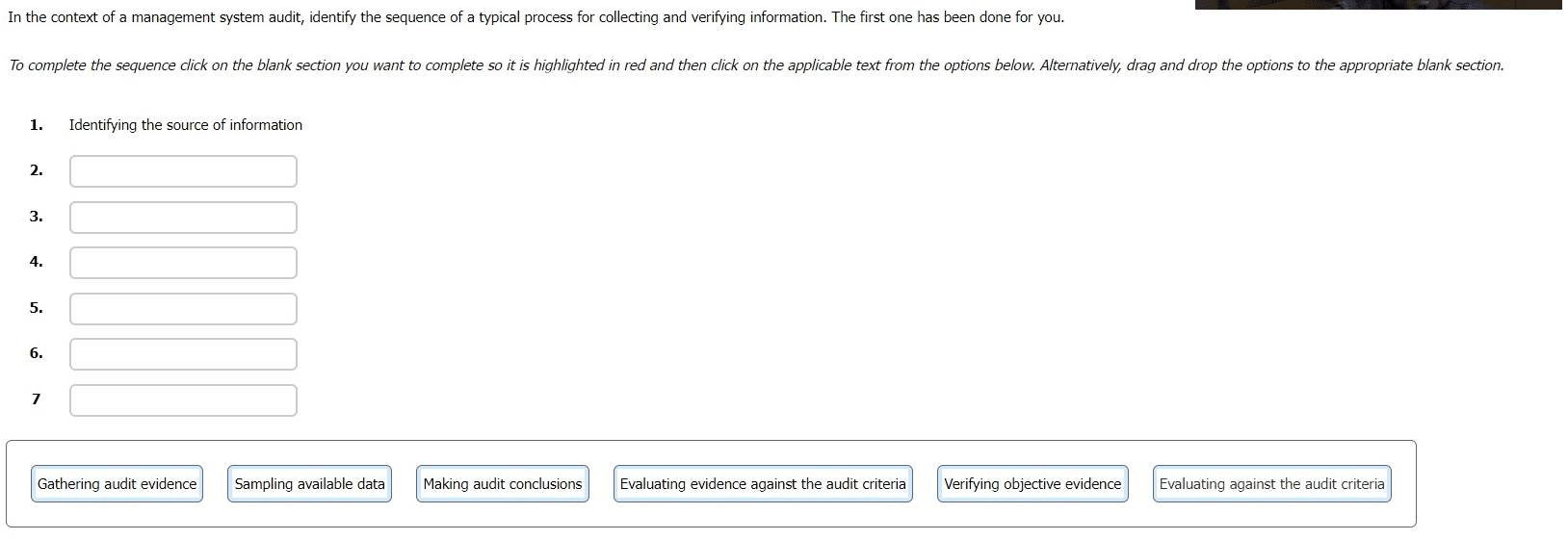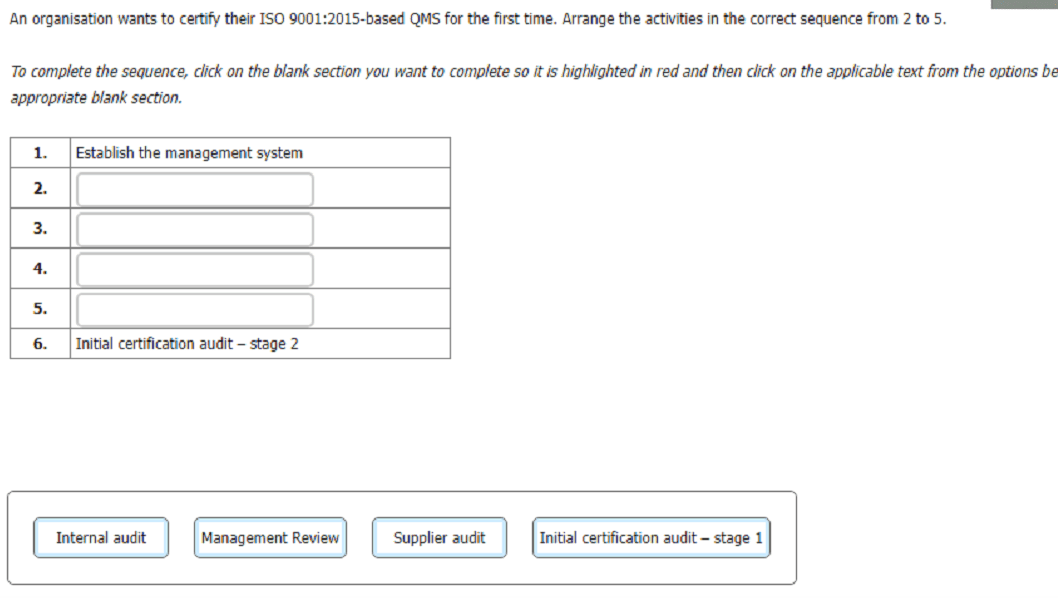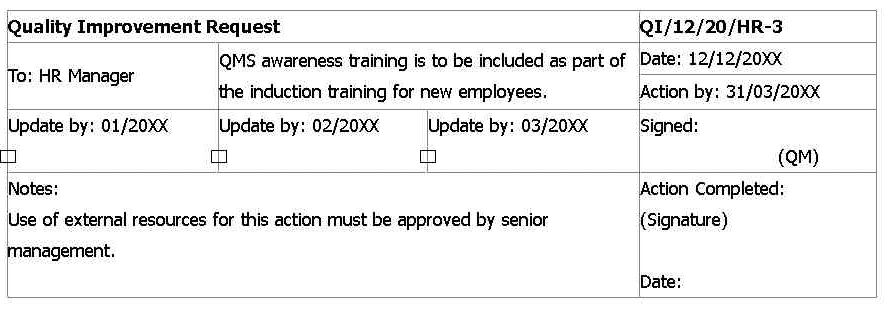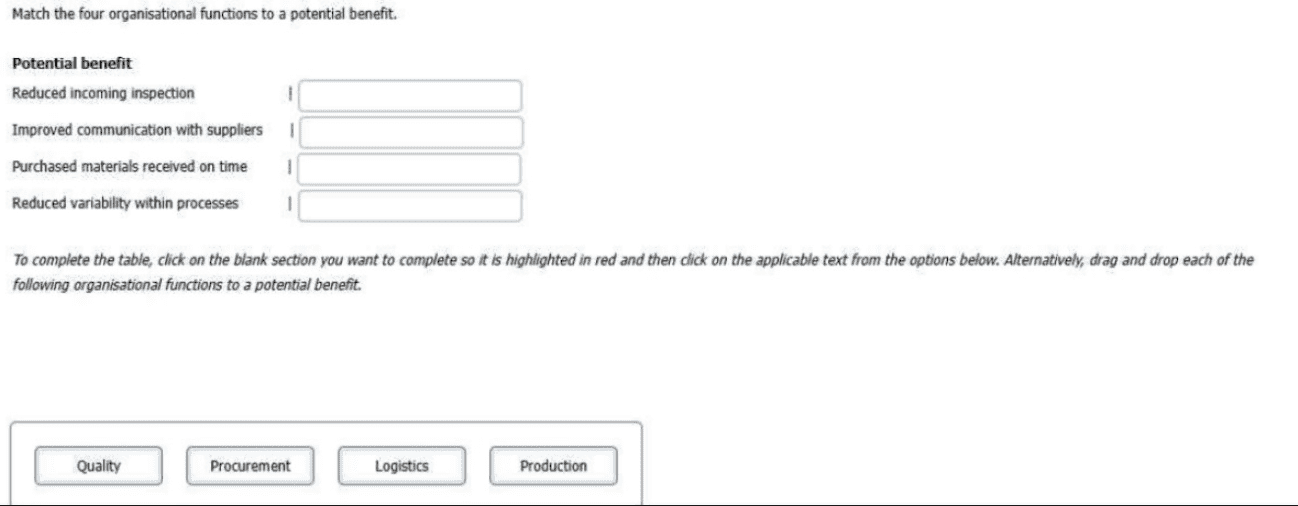PECB ISO-9001-Lead-Auditor - QMS ISO 9001:2015 Lead Auditor Exam
Auditor competence is a combination of knowledge and skills. Which two of the following activities are predominately related to 'knowledge'?
Which one of the following options best describes the purpose of a Stage 1 third-party audit?
In the context of a management system audit, identify the sequence of a typical process for collecting and verifying information. The first one has been done for you.
To complete the sequence click on the blank section you want to complete so it is highlighted in red and then click on the applicable text from the options below. Alternatively, drag and drop the options to the appropriate blank section.

An organisation wants to certify their ISO 9001:2015-based QMS for the first time. Arrange the activities in the correct sequence from 2 to 5.
To complete the sequence, click on the blank section you want to complete so it is highlighted in red and then click on the applicable text from the options below. Alternatively, drag and drop the
options to the appropriate blank section.

XYZ Corporation is an organisation that employs 100 people. As audit team leader, you are conducting a
certification audit at Stage 1. When reviewing the quality management system (QMS) documentation, you
find that quality objectives have been set for every employee in the organisation except top management.
The Quality Manager complains that this has created a lot of resistance to the QMS, and the Chief Executive
is asking questions about how much it will cost. He asks for your opinion on whether this is the correct
method of setting objectives.
Three months after Stage 1, you return to XYZ Corporation to conduct a Stage 2 certification audit as Audit
Team Leader with one other auditor. You find that the Quality Manager has cancelled the previous quality
objectives for all employees and replaced them with a single objective for himself. This states that "The
Quality Manager will drive multiple improvements in the QMS in the next year". The Quality Manager indicates
that this gives him the authority to issue instructions to department managers when quality improvement is
needed. He says that this approach has the full backing of senior management. He shows you the latest
Quality Improvement Request that was included in the last management review.

After further auditing, the issues below were found. Select two statements that apply to the term
`nonconformity'.
XYZ Corporation is an organisation that employs 100 people. As the audit team leader, you conduct a certification audit at Stage 1. When reviewing the quality management system (QMS), you find that the objectives have been defined by an external consultant using those of a competitor, but nothing is documented. The Quality Manager complains that this has created a lot of resistance to the QMS, and the Chief Executive is asking questions about how much it will cost.
Which two options describe the circumstances in which you could raise a nonconformity against clause 6.2 of ISO 9001?
An organisation decides to purchase products and services only from ISO 9001 certified suppliers.
Match the four organisational functions to a potential benefit.

Scenario 6: Davis Clinic (DC) is an American medical center focused on integrated health care. Since its establishment DC was committed to providing qualitative services for its clients, which is the reason why the company decided to implement a quality management system (QMS) based on ISO 9001. After a year of having an active QMS in place, DC applied for a certification audit.
A team of five auditors, from a well-known certification body, was selected to conduct the audit. Eva was appointed as the audit team leader. After three days of auditing, the team gathered to review and examine their findings. They also discussed the audit findings with DC's top management and then drafted the audit conclusions.
In the closing meeting, which was held between the audit team and the top management of DC. Eva presented two nonconformities that were detected during the audit. Eva stated that the company did not retain documented information regarding its outsourced services for an analysis laboratory and regarding the conducted management reviews. During the closing meeting, the audit team required from DCs top management to come up with corrective action plans within two weeks. Although the top management did not agree with the audit findings, the audit team insisted that the auditee must submit corrective actions within the given time frame in order for the audit activities to continue.
Once the action plans were evaluated, the audit team began preparing the audit report. Eva required from the team to provide accurate descriptions of the audit findings and the audit conclusions. The report was then distributed to all the interested parties involved in the audit, including the certification body Based on the report, the certification body together with Eva, as the audit team leader, made the certification decision.
Based on the scenario above, answer the following question:
Scenario 6 indicates that although the top management did not agree with the audit findings, the audit team began preparing the audit report. Is this acceptable?






